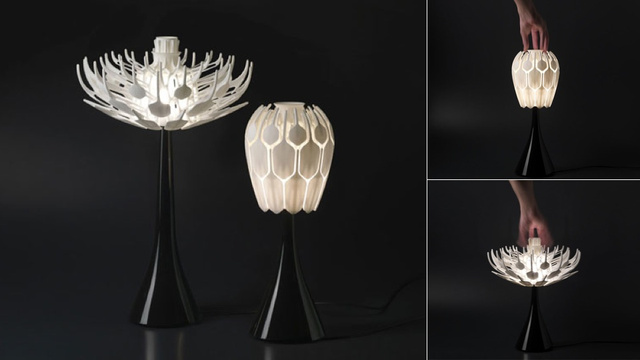
A flower” lamp created using AM. Courtesy of Patrick Jouin.”
September 25, 2012
In the course of my diligent efforts to keep you good people up to date on the state of additive manufacturing, I come across many interesting news items. I’ll gather them up every so often and present them in a Rapid Ready Roundup (like this one). You can find the last Roundup here.
We’ll start today with news that probably won’t come as much of a surprise to anyone paying attention to the additive manufacturing (AM) industry. Stratasys shareholders voted nearly unanimously in favor of the proposed merger with Objet. As a reminder, when the deal is finalized, Stratasys, “…will merge with a subsidiary of Objet, and each former Stratasys common share will be converted into the right to receive one newly issued share of the combined company’s common stock.”
When people think of CAD design files for 3D printing, chances are they think of .stl. A number of groups (including ASTM) are looking to the future of AM and see the technology using a different file type: .amf. The new file format is XML-based and is open source, which allows for more collective brain power to figure out best practices for AMF.
According to 3D printing industry consultant Todd Grimm, “I believe there is an even more pervasive technology gap — one that exists between the CAD and the 3D printer and hinders functionally graded materials as well as full-color printing and microstructures: The simple STL file format is unable to communicate such sophisticated design elements!”
Here’s a quickie. French designer Patrick Jouin is using AM to create lamps that are works of art. The lamps have two “settings.” One is with the petals drawn up, to provide a dim light; the other is with the petals down to provide a brighter light. I find either effect to be fantastic.
We’ve talked before about scientists using AM to recreate models of creatures that lived on the planet in previous ages. More recently, researchers at the University of Texas at Austin used a CT scan to digitally reproduce, then 3D print a Protobalanus spinicoronatus (an armored mollusk). The last time the creature saw the light of day was some 390 million years ago.
The mollusk left bits and pieces of itself in the fossil record, but never enough parts in one place to allow for full reconstruction. The researchers collated all the data to create the digital design. This new technique is becoming a useful tool for scientists to more accurately reconstruct extinct species.
Below you’ll find a video of the digital reconstruction work done on the mollusk. A longer video can also be found here.
Sources: Stratasys, National Geographic, Objet, Gizmodo
Subscribe to our FREE magazine, FREE email newsletters or both!
About the Author
John NewmanJohn Newman is a Digital Engineering contributor who focuses on 3D printing. Contact him via [email protected] and read his posts on Rapid Ready Technology.
Follow DE






